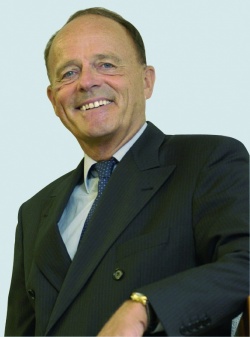Schiller AG - Pace maker of trends in emergency medicine
In Switzerland, they say, the clocks tick a little slower than elsewhere in the world. Not at Schiller AG in Baar, however: The company remains forever ahead of the times. Since 1971, physicist Alfred E Schiller, the company’s founder and managing director, has successfully shown competitors in the tough intensive and emergency care market what innovative progress really means.


This internationally active medical technology company, which years ago made waves with the launch of the first six-channel ECG with automatic measurement and interpretation, today has 25 subsidiaries and 700 employees worldwide.
To set the pace in the highly technology driven core businesses of cardiopulmonary diagnostics, patient monitoring and external defibrillation, Schiller AG builds on two strengths: a good ‘nose’ for trends and enthusiastic research and development. Indeed, when interviewed by Daniela Zimmermann of European Hospital, 66-year-old Alfred Schiller said he is in the firm’s innovation studio every day.
2009 was an economically difficult year for businesses just about everywhere. Not so for Schiller AG. ‘For us, it was very good,’ said Alfred Schiller. ‘In Germany, Switzerland and Austria we recorded no sales losses whatsoever. In France we were even able to increase sales by 30% thanks to large public contracts we were awarded. In Italy, where Esaote has been representing our company for the past 17 years, things are also going well. However, I think that, in the future, there won’t be any huge economic booms. They just won’t happen any more.’
Why is Schiller particularly famous for ECG equipment and pocket-size defibrillators?
Size and weight of the devices play a crucial role, particularly for emergency services, because paramedics and firemen very often have to cover the last metres to an accident site on foot and are carrying lots of equipment. We have recognised this problem very early and solved it using highly integrated microelectronics and state-of-the-art battery and power pack technology. While conventional monitoring/defi systems for emergency medicine weigh nine to 10 kg, our new Argus Pro LifeCare 2 is half of that -- 4.4 kg. The robust light-weight material is used in the aircraft industry. Nevertheless, the device offers all functions: 12-channel ECG, pacemaker, capnography (etCO2), pulse oximetry (SpO2), invasive blood pressure (IBP), non-invasive blood pressure (NIBP) and temperature measurement – all with uncompromised performance.
Can the ECG data be transferred from the device to a hospital information system (HIS)?
No problem. The device even features a wireless LAN, which means it’s highly mobile. Alternatively, mobile communication technologies, such as GSM (Global System for Mobile Communications) or UTMS (Universal Mobile Telecommunications System), can be used to transfer the data from the emergency site to the hospital. You can not only transmit the data but also collect them in an ECG data management system in order to document them for quality management purposes. However, interoperability is still a problem in many countries: imposing standardisation of interfaces requires know-how as well as political will. Often neither is present. Therefore, as medical technology providers, we increasingly have to become IT experts who offer complete solutions and consulting services for systems integration. As a member of Integrating Healthcare Enterprises (IHE) at Schiller we can already transfer all our data from conversion programmes to existing systems.
Schiller’s new Cardiovit MS-2010 electrocardiography device was launched at the World Congress of Cardiology this June. What trends does this device exemplify?
This is an entirely new generation of devices that looks towards modern tablet PCs, such as the iPad, for guidance. They feature, for example, touchscreen user interfaces. A few years ago this was entirely impossible since the users did not accept such technologies. Today, modern means of communication are ubiquitous, a part of our everyday life. Moreover, the mobile phone industry showed us that miniature devices can offer incredible performance. Technical systems and home entertainment electronics are no longer separate entities. This fusion also impacts on the requirement profile of our customers. No doubt, IT and miniaturisation of devices will become ever more important in medical technology.
How do you rate Asian competition in medical technology?
You know, medical technology is not very different from cars; they all have four wheels, a steering wheel and an engine. Nonetheless, there are huge differences in terms of quality and extras. Look at China, for example -- there you find our major copyists. For Chinese manufacturers, Schiller is the ideal they want to emulate. However, in no major Chinese hospital will you find Chinese equipment; you will only find the foreign originals. If you want to purchase quality in China, you’ll have a tough time finding it. In Europe we still lead in engineering and we will be able to maintain this advantage for years to come, if we keep our production sites here. Therefore, we will continue to manufacture our products primarily in Switzerland, France and Germany.
ARGUS PRO LifeCare 2
Defibrillator, pacemaker, patient monitor and 12-channel ECG in a compact design
Features:
- Only 4.4 kg and extremely robust
- Intuitive operator guidance
- 8.4" colour display, transflective
- 6-channel ECG recorder, 114 mm wide paper, Z-folded, 30 m long
- NIBP, 4 x IBP, 2 x temp., SpO2, etCO2
- Defibrillator with AED and manual mode
CARDIOVIT MS-201
ECG diagnostic system
Features:
- 10.4" full colour touch display
- Instant-on and ECG printout in less than 3 seconds
- Storage of up to 350 ECGs
- Connect via LAN, WLAN or GPR
- Support for HL7 work lists
- First high-end electrocardiography to support DICOM standard
20.08.2010
- cardiology (772)
- display (438)
- emergency medicine (313)
- heart attack (181)
- markets (545)
- medical technology (1544)











